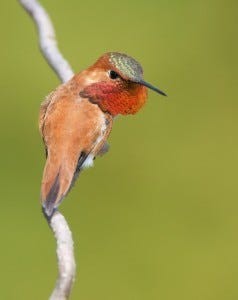Why Do Hummingbirds Chase Each Other? This is a common question among bird enthusiasts. At WHY.EDU.VN, we delve into the fascinating world of hummingbird behavior, offering insights into their territorial disputes and providing solutions to foster a more harmonious feeding environment. Discover the reasons behind these aerial chases and learn how to create a hummingbird haven in your backyard with expert tips, feeding strategies, and advice on managing hummingbird aggression.
1. Unveiling the Mystery: Why Hummingbirds Engage in Chasing Behavior
Hummingbirds, despite their diminutive size and charming appearance, often exhibit surprisingly aggressive behavior. Understanding why these tiny creatures engage in constant chases is essential for anyone looking to attract and sustain a thriving hummingbird population. This section explores the primary motivations behind this behavior, focusing on territoriality, resource competition, and mating rituals.
1.1. Territoriality: Defending Their Feeding Turf
Hummingbirds are fiercely territorial, especially when it comes to defending their food sources. A single hummingbird may claim ownership over a feeder or a patch of nectar-rich flowers, viewing any other hummingbird as an intruder. This possessive instinct drives them to chase away rivals, ensuring they have exclusive access to the precious nectar.
- Defending Nectar Sources: Hummingbirds have high energy needs due to their rapid metabolism and flight patterns. They need to defend flowers or hummingbird feeders, which are important sources of nectar, from being taken over by other hummingbirds.
- Establishing Dominance: Hummingbirds show that they are more powerful than other hummingbirds by chasing them away. This helps them establish a pecking order at the feeder.
- Reducing Competition: A hummingbird can make sure it gets enough food by getting rid of other hummingbirds.
1.2. Resource Competition: The Fight for Nectar
Nectar is the primary food source for hummingbirds, providing them with the energy they need to sustain their high-energy lifestyle. However, nectar sources can be limited, leading to intense competition among hummingbirds. When resources are scarce, hummingbirds will aggressively defend their access to ensure their survival.
1.3. Mating Rituals: Asserting Dominance for Breeding Rights
Chasing is not always about food; it can also be a crucial part of hummingbird mating rituals. Male hummingbirds often engage in elaborate aerial displays and chases to attract females and assert their dominance over rivals. These displays showcase their strength, agility, and overall fitness, signaling their suitability as a mate.
2. Decoding Hummingbird Aggression: Recognizing the Signs
Understanding the different forms of aggression that hummingbirds display is crucial for interpreting their behavior and implementing effective management strategies. This section details the various ways hummingbirds express their territoriality, from vocalizations and body language to physical confrontations.
2.1. Vocalizations: Warning Calls and Threatening Buzzes
Hummingbirds use a variety of vocalizations to communicate their territorial claims. These include sharp, rapid chirps, buzzing sounds, and high-pitched calls that serve as warnings to other hummingbirds. Recognizing these sounds can help you identify when territorial disputes are occurring in your yard.
2.2. Body Language: Posturing and Displays
Hummingbirds use body language to communicate their intentions and intimidate rivals. This includes puffing up their feathers to appear larger, flaring their gorgets (brightly colored throat feathers), and displaying their wings and tails to showcase their size and strength. These displays are often used to ward off intruders before resorting to physical aggression.
 Rufous Hummingbird Flaring Gorget
Rufous Hummingbird Flaring Gorget
2.3. Aerial Displays: Dives and Chases
Aerial displays are a common form of aggression among hummingbirds. These displays involve the defending hummingbird diving at intruders, chasing them through the air, and engaging in high-speed pursuits. These chases are designed to intimidate and drive away rivals, reinforcing the territorial boundaries.
2.4. Physical Confrontations: When Warnings Escalate
In some cases, warnings and displays are not enough to deter intruders, leading to physical confrontations. Hummingbirds may use their sharp bills and claws to attack rivals, resulting in injuries or even death. While physical altercations are less common than other forms of aggression, they can occur when territorial disputes escalate.
3. Species-Specific Aggression: Identifying the Bully Breeds
Some hummingbird species are known to be more aggressive than others. Identifying these “bully breeds” can help you anticipate and manage territorial behavior in your yard. This section highlights some of the most aggressive hummingbird species and their typical behaviors.
3.1. Rufous Hummingbird: The Infamous Bully
The Rufous Hummingbird is widely regarded as one of the most aggressive hummingbird species in North America. These tiny dynamos are known for their fiery temperament and relentless pursuit of rivals. Rufous Hummingbirds are particularly assertive during migration, when they aggressively defend feeding territories along their route.
3.2. Anna’s Hummingbird: Year-Round Territoriality
Anna’s Hummingbirds are known for their year-round territoriality, defending their feeding and breeding territories with vigor. These birds are commonly found along the Pacific Coast and are quick to chase away any intruders that dare to enter their domain.
3.3. Allen’s Hummingbird: Coastal Defenders
Allen’s Hummingbirds, closely related to Rufous Hummingbirds, also exhibit strong territorial behavior. These birds are commonly found in coastal California and Oregon, where they aggressively defend nectar sources and breeding sites.
3.4. Ruby-Throated Hummingbird: Eastern Aggressors
Ruby-Throated Hummingbirds, the only breeding hummingbird species in eastern North America, can also be quite territorial. While they may not be as overtly aggressive as Rufous Hummingbirds, they will still defend their feeding territories against rivals, especially during the breeding season.
4. Minimizing Aggression: Strategies for Peaceful Feeding
Creating a harmonious feeding environment for hummingbirds requires implementing strategies that minimize aggression and promote peaceful coexistence. This section provides practical tips for reducing territorial behavior and ensuring that all hummingbirds have access to the nectar they need.
4.1. Multiple Feeders: The Key to Harmony
One of the most effective ways to reduce aggression is to provide multiple hummingbird feeders. By increasing the number of feeding stations, you can dilute the competition and make it more difficult for a single hummingbird to dominate the entire area.
- Creating Feeding Zones: By strategically placing hummingbird feeders in a garden, hummingbirds can be given more room to feed, which can lower the amount of competition and fighting.
- Decreasing Dominance: When many hummingbird feeders are available, it is more difficult for one hummingbird to take over a specific feeder.
- Attracting More Hummingbirds: The sounds of feeding and fighting may attract a larger number of hummingbirds to the feeders and the yard.
4.2. Feeder Placement: Strategic Positioning
The placement of hummingbird feeders can also impact territorial behavior. Placing feeders in different locations, out of sight of each other, can prevent dominant hummingbirds from controlling multiple feeders at once.
- Distance Between Feeders: To reduce the amount of competition, put hummingbird feeders a good distance apart so that one hummingbird cannot see the other.
- Using Natural Barriers: Place feeders in front of trees, shrubs, or other natural barriers to visually separate feeding zones.
- Varying Heights: Hummingbird feeders should be positioned at various heights so that different hummingbirds can locate a feeding spot that suits them best.
4.3. Feeder Design: Choosing the Right Style
The design of your hummingbird feeders can also influence aggression. Feeders with multiple feeding ports allow more hummingbirds to feed simultaneously, reducing the likelihood of territorial disputes.
- Horizontal Feeders: Hummingbird feeders that are horizontal make it possible for more hummingbirds to feed at the same time, which lowers the amount of competition.
- Perchless Feeders: Taking perches off of feeders will force hummingbirds to hover when they are eating, which will make it more difficult for them to stay there for long periods of time and guard the feeder.
- Size and Capacity: Hummingbird feeders with a larger capacity can feed more hummingbirds, which cuts down on the amount of fighting.
4.4. Removing Perches: Discouraging Loitering
Hummingbirds often perch near feeders to guard their territory and chase away rivals. Removing or modifying perches can discourage this behavior, encouraging hummingbirds to feed and move on, reducing the potential for conflict.
4.5. Providing Natural Nectar Sources: Planting for Peace
Supplementing hummingbird feeders with natural nectar sources can also help reduce aggression. Planting nectar-rich flowers in your yard provides additional feeding opportunities, diluting competition and creating a more peaceful environment.
- Native Plants: Use indigenous plants that supply nectar throughout the entire growing season to attract a wide variety of hummingbirds.
- Variety of Blooms: Hummingbirds are drawn to a wide array of flower species, which offers them a variety of food sources.
- Succession Planting: Hummingbirds may find food throughout the entire season if they plant flowers that bloom in succession.
5. Expert Insights: Advice from Ornithologists
To provide a comprehensive understanding of hummingbird behavior, we’ve gathered insights from leading ornithologists and bird experts. This section features expert advice on managing hummingbird aggression and creating a thriving habitat.
5.1. Bob Sargent: Increasing Feeder Numbers
Bob Sargent, a long-time hummingbird bander and bird expert, suggests increasing the number of hummingbird feeders around July 4th. This is when nesting ends and the first southbound migrants begin to arrive in large numbers.
5.2. Removing Favorite Perches
Another tip from Bob Sargent is to locate and remove a bully hummingbird’s favorite hiding spot. These birds often stake out a spot that allows a good vantage point of their territory. Removing the perch or pruning the branch they typically use can prevent them from chasing away other hummingbirds.
6. Understanding Hummingbird Behavior: Debunking Myths
There are several myths and misconceptions surrounding hummingbird behavior. This section addresses common misconceptions and provides accurate information based on scientific research and expert observations.
6.1. Myth: Separating Feeders Solves Aggression
An old rule of thumb was to separate hummingbird feeders to address bully behavior. However, this can actually encourage more bullies to claim individual territories. The real answer is to add more feeders and place them in clusters.
6.2. Myth: Hummingbirds Only Fight Over Food
While food is a primary driver of aggression, hummingbirds also fight over breeding territories and mates. Understanding the full range of motivations behind their behavior is essential for effective management.
6.3. Myth: All Hummingbirds are Equally Aggressive
Some hummingbird species are known to be more aggressive than others. Recognizing these “bully breeds” can help you anticipate and manage territorial behavior in your yard.
7. Monitoring and Maintenance: Ensuring a Healthy Habitat
Maintaining a healthy hummingbird habitat requires regular monitoring and maintenance. This section provides tips on keeping feeders clean, preventing disease, and ensuring that your yard remains a welcoming environment for these fascinating birds.
7.1. Regular Cleaning: Preventing Disease
Regularly cleaning hummingbird feeders is crucial for preventing the spread of disease. Clean feeders at least once a week with hot, soapy water, and rinse thoroughly before refilling.
7.2. Fresh Nectar: Avoiding Spoilage
Spoiled nectar can be harmful to hummingbirds. Replace the nectar in your feeders every few days, especially during hot weather, to ensure that it remains fresh and safe.
7.3. Monitoring Activity: Identifying Potential Problems
Keep an eye on your hummingbird feeders and the surrounding area to identify any potential problems. Look for signs of disease, aggression, or other issues that may require intervention.
8. Attracting More Hummingbirds: Creating a Hummingbird Haven
Creating a hummingbird haven in your yard involves more than just providing feeders. This section offers tips on attracting more hummingbirds by providing the right food, water, and shelter.
8.1. Planting Nectar-Rich Flowers: A Natural Buffet
Planting nectar-rich flowers is one of the best ways to attract hummingbirds to your yard. Choose a variety of native plants that bloom at different times of the year to provide a continuous source of nectar.
8.2. Providing Water Sources: More Than Just Nectar
Hummingbirds also need access to water for drinking and bathing. Provide a shallow dish of water or a gentle sprinkler to attract these birds and keep them hydrated.
8.3. Offering Shelter: Safe Havens
Hummingbirds need shelter from predators and harsh weather conditions. Provide trees, shrubs, and other plants that offer protection and nesting sites.
9. The Role of WHY.EDU.VN: Answering Your Questions
At WHY.EDU.VN, we understand the challenges of creating a harmonious environment for hummingbirds. Our platform is dedicated to providing accurate, reliable information and expert advice to help you address your questions and concerns.
9.1. Expert Answers: Reliable Information
Our team of experts is available to answer your questions about hummingbird behavior, feeding strategies, and habitat management. We provide evidence-based information to help you make informed decisions and create a thriving hummingbird habitat.
9.2. Community Support: Sharing Experiences
Join our online community to connect with other hummingbird enthusiasts, share your experiences, and learn from others. Our community is a valuable resource for exchanging tips, advice, and support.
9.3. Resources and Tools: Enhancing Your Knowledge
We offer a variety of resources and tools to enhance your knowledge and understanding of hummingbird behavior. Explore our articles, guides, and videos to learn more about these fascinating birds and how to create a welcoming habitat.
10. Conclusion: Fostering a Thriving Hummingbird Population
Understanding why hummingbirds chase each other is the first step in creating a harmonious feeding environment. By implementing the strategies outlined in this article, you can minimize aggression, promote peaceful coexistence, and foster a thriving hummingbird population in your yard. At WHY.EDU.VN, we’re committed to providing the information and support you need to succeed.
By providing multiple feeders, strategic placement, and natural nectar sources, you can create a hummingbird haven that benefits both the birds and your own enjoyment. Remember to regularly clean and maintain your feeders to prevent disease and ensure that your yard remains a welcoming environment for these fascinating creatures.
Visit WHY.EDU.VN at 101 Curiosity Lane, Answer Town, CA 90210, United States, or contact us via WhatsApp at +1 (213) 555-0101 for more information and expert advice. Let us help you unlock the secrets of hummingbird behavior and create a thriving habitat for these amazing birds.
FAQ: Understanding Hummingbird Behavior
1. Why are hummingbirds so aggressive?
Hummingbirds are aggressive due to their strong territorial instincts, especially when it comes to defending their food sources and breeding territories.
2. How can I stop hummingbirds from fighting at my feeder?
Provide multiple feeders placed out of sight of each other, remove perches, and plant natural nectar sources to reduce competition.
3. Which hummingbird species is the most aggressive?
The Rufous Hummingbird is widely regarded as one of the most aggressive hummingbird species.
4. Do male and female hummingbirds exhibit the same level of aggression?
Male hummingbirds tend to be more territorial and aggressive than females, especially during the breeding season.
5. Is it normal for hummingbirds to chase each other?
Yes, chasing is a common behavior among hummingbirds, especially when they are defending their territories or competing for mates.
6. How do hummingbirds communicate their aggression?
Hummingbirds communicate aggression through vocalizations, body language, aerial displays, and, in some cases, physical confrontations.
7. Can hummingbird fights result in serious injuries or death?
Yes, while less common, physical altercations can result in injuries or even death, especially if one hummingbird is significantly weaker than the other.
8. What is the best way to attract more hummingbirds to my yard?
Plant nectar-rich flowers, provide multiple feeders, offer a water source, and provide shelter to attract more hummingbirds.
9. How often should I clean my hummingbird feeders?
Clean your hummingbird feeders at least once a week with hot, soapy water to prevent the spread of disease.
10. Where can I find more information about hummingbird behavior?
Visit why.edu.vn for expert advice, reliable information, and community support to enhance your knowledge of hummingbird behavior.

